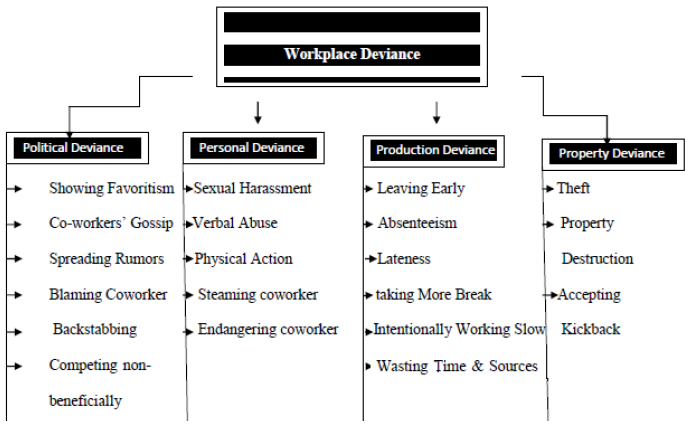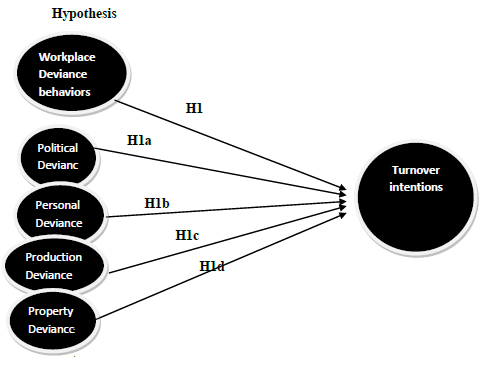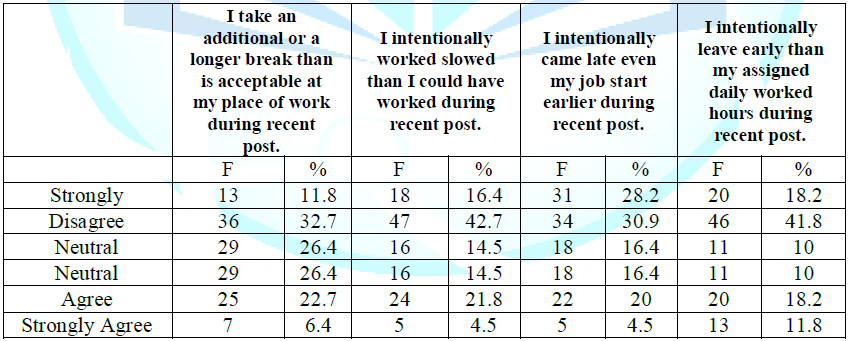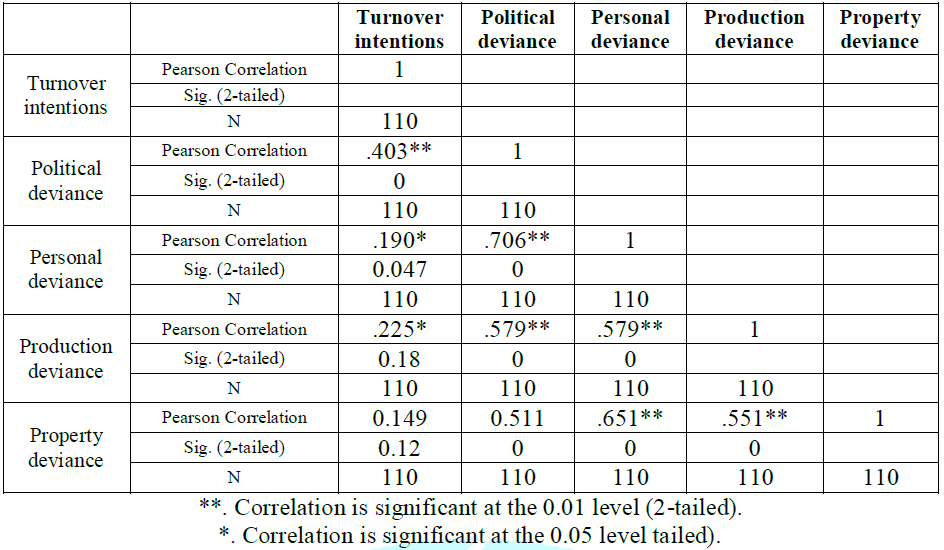Research Article :
Workplace deviance behaviors are a negative fact
that damages people who working within them and organizations without sound.
This particular study is on finding out the Impact of Workplace Deviance
Behaviors on Turnover Intentions of Employees in Pakistan. For this purpose
researcher conduct a one short study that examine a sample of 110 employees
from private and governmental organizations from Lahore, Pakistan. Our research
help to people who want to know about Workplace Deviance and its consequences,
and corrective measures of this behavior. For analysis purpose researcher used
descriptive, frequency and correlation analysis. Result shows that most of
people in Pakistan thing to leave an organization/ current job with offering
new one. Turnover Intentions has positive and significant relationship with
Political Deviance, Personal Deviance, and Production Deviance but Turnover
Intentions has insignificant relationship with Property Deviance. This study is about to find the impact of workplace deviance
behaviors on
turnover intentions of employees in Pakistan. The study is helpful for various
private and government organizations to knowing about workplace deviance and
its consequences. Workplace deviance has become very interesting topic for
research since last 20 years. Workplace deviance is due to mistreatment in
workplace that effect employees and organizational effectiveness and it is very
harmful in a negative form for any organization. Because it leads towards
employees that is followed increase in turnover intention, intention to leave,
workplace theft absenteeism, property destructions, waste time & sources,
and many other similar negative reactions. And ultimately deviance behaviors in
workplace cause to destroy organizational commitment and financial &
non-financial repute of the organizations. Our research topic is impact of workplace deviance on
turnover intention of employees in Pakistan study include workplace deviance as
an independent variable and turnover intention as dependent variable. There are
4 dimensions and its elements of deviance behaviors include this research
study, these dimensions are political deviance, personal deviance, production
deviance, and property deviance. Because of workplace deviance organizations
face many problems but one of the main problems that under discussion in this
paper is turnover intention, this study conduct to find relationship or
correlation between workplace deviance and turnover intentions. The problem which is focused by researcher in this
particular study to know about the impact and relationship between workplace
deviance behavior and turnover intention of employees in Pakistan. There is
however several form of workplace deviance behaviors such as, political,
personal, production and property deviance behaviors that will lead to turnover
intentions among employees at workplace which affect the accomplishment of set
goals of the organizations. So without eliminating these types of negative
behaviors at workplace they said vices are likely to continue and slowdown the
achievement of the organizations set goals. Need arises to examine the deviance
behaviors at
workplace in Pakistan hence this proposed research. • To explain the concept of workplace deviance • To elaborate the concept of turnover intentions • To measure the Impact of personal deviance behavior on
turnover intention of employee, • To determine the Impact of property deviance behavior on
turnover intention of employee, • To assess the Impact of production deviance behavior on
turnover intention of employee, • To describe the Impact of political deviance behavior on
turnover intention of employee, • To calculate the impact of workplace deviance on turnover
intentions, • To find the relationship among workplace deviance &
its dimensions and turnover intentions. The present study focuses on workplace deviance
behaviors and its impact and cause to increase turnover intentions in
employees. After knowing about turnover intentions, the policy makers in an
organization take it into consideration while making policies and taking
important decisions to deviance behaviors in workplace. This study includes workplace deviance, its dimensions,
& its elements and turnover intention as overall. But it is important to
mention that researcher does not includes two elements of political deviance
named as backstabbing & competing non-beneficially, one element of personal
deviance called endangering coworker, and two elements of production deviance
named as intentionally working slow & wasting time and sources in this
particular study. Workplace deviance behavior is voluntary behavior of
individual or group of individual that violates significant organizational
norms and threatened the wellbeing
of the organization or its members by doing so. There are many others names
used for workplace deviance like; counterproductive behavior, antisocial behavior,
and workplace incivility (Robinson & Bennett, 2011). Another researcher
explain workplace deviance in his book as workplace deviance behavior (WDB)
refers to an intentional acts executed by employees of the organization that
violate norms of the organization and have capacity to maltreat the
organization or members of the organization (Cooper & Klimosk, 2007). The
tern of deviance are characterized in the context of employees who
intentionally steal, come late on job, procrastinate, goof off, fail to provide
proper services to their customers and clients, forget to provide detailed report
to supervisors and otherwise destruct or downfall the goals for the
organization (Elias, 2013). And organizational norms include both formal and
informal organizational rules & regulations, policies & procedure, and
method of conducting routine business. There are many scientists identified that workplace deviance
in reaction cause to frustrating organizational stressors like; social,
financial, and working condition in workplace (Spector & Fox, 2004).
Workplace deviance is a well interesting and observed topic in these days in
both academic and practical research. Researchers identified that workplace
deviance is a very serious problem in both manufacturing and services firms
because its consequences are very bad in term of financial and non-financial
repute of the organizations (Giacalone & Jurkiewicz, 2005). As all
definitions of workplace deviance behaviors mentioned above it is a behavior of
organizational employees who intentionally violate the border of the
organization that lead to many losses for the business may in the form of
satisfaction and dissatisfaction of the other employees, in this particular
study workplace used as independent factor to indicate the job satisfaction of
the employees. According to different researchers different classifications
of workplace deviance, some divide workplace deviance into positive and
negative group, some divert it into minor vs. serious & personal vs.
organizational and some classified it into severity and target dimension of
workplace deviance (Lawrence & Robinson, 2007). There are four main
dimensions of workplace deviance first time discussed by Robinson and Bennett
in his paper published in 1995 and after that many researchers also cod these
dimensions as it is and these dimensions have many elements with its occurrence
on workplace. Figure1: Dimensions of workplace deviance and its elements. Political deviance is considers as minor form of deviance
behavior in which one employee or group of employees show favoritism for other
certain stakeholders like; co-workers, customers, and suppliers of the
organization. Political deviance may include gossip about co-workers, spreading
rumors about organization and employees, blaming co-workers and supervisions,
backstabbing and competing non-beneficially. Undercharging preferred customers
and sharing companies secretes also include in political deviance behavior that
may result to high cost for the organizations (Eddleston & Kidder, 2006). Personal is a major and negative form of deviance behavior
in workplace in which includes hostile or aggression behavior of individual who
have negative thinking
against other employees. Political Deviance Personal Deviance Production
Deviance Property Deviance Personal deviance is very harmful for well repute of
the organization. It may also includes sexual harassment, verbal abuse against
some one other employee, physical
action to interrupt or distrust work of others, steaming co-worker, and
endangering for co-workers (Geffner & Li, 2012). Production deviance also considered as minor or positive
form of workplace deviance behavior in which employees consistently violate the
rules and set standard for quality and quantity for producing a goods and
services, It may also be quite costly for the organization, loss of control
over predefine set standard of production may cause to increase cost of
production for the company, production deviance may also includes leaving
early, absenteeism, lateness, taking more break, intentionally working slow,
and wasting time & resources (Borman & Klimoski, 2003) Property deviance known as serious form of workplace
Deviance behavior in which employees of the company destroy or destruct the
property of the company without permission of the company, it may also a
harmful and costly for the organizations, it includes employees involve in
theft of inventory, property destruction, accepting kickback, stealing
products, add wrongly additional expenses in accounts, it has negative effect
on organizational bottom line (Lawren, 2010). Turnover intention is define as employees desire or willingness to leave an
organization or it is a process in which staff of the organization or business
leave that organization or business or turnover intention is measurement of
business or organizations employees plan to leave their positions, it may be
voluntary or involuntary (Chen, 2008). One of the most important studies was conducted to find out
relationship between workplace incivility and turnover intentions with title workplace
incivility and turnover intentions: the efficiency of managerial investors in
which one public hospital with 550 bad, located in southeastern United States.
The data were collected from nurses at two waves or two time and interval
between these two waves were 5 months of time. Study includes workplace
incivility, team building, personal management interview, and work shift as an
independent variables and turnover intentions as dependent variable. At first
time data were collected from nurses for workplace incivility, work shift, team
building, and interview and turnover intentions and at second time data
collected for turnover intention and workplace incivility. Total 979 nurses include in this survey and out of this 721
nurses fill full content of questionnaire. It means total response rate about
73%. A different likert-type scale questionnaire used for each variable
includes this study. Turnover intentions measure by 1= not at all look for
other job, 7= extremely likely, workplace incivility measure through 5 point
scale as, 1= never, to 5= very often, team building measured as cod 1= response
with team building or 0 for otherwise, personal managerial interview as 1= not
hold individual meeting, to 10= more than once in every week and work shift
also measured by cod. And then apply confirmatory factors analysis (CFA) and
cross lagged model and result shows that workplace incivility has positive
relationship with turnover intentions even after 5 months. And overall result
indicates that incivility has negative consequences for turnover (Bagozzi &
Huy, 2009). This study conduct under the title of curtailing incivility:
contextual factors, citizenship behaviors, and managerial practices. In which
three question used by researchers to find out the impact of incivility on
turnover intentions, contextual factors like; 1.role ambiguity and work shift
may increase the effect of workplace incivility on turnover intentions of
employees, 2.employees who engaged in positive behaviors like; citizenship behaviors
has not affected by incivility behaviors on workplace and not affect to
increase in intention to leave, and 3. Managerial practices like; personal
management interview and team building may help organization to the effect of
incivility on turnover intentions, for the purposes of calculation conduct a
longitudinal study that taken sample of 721 nurses who are working in a public
research hospital. And overall result shows that employees who experienced role
ambiguity and working on night shift increase affect of incivility on turnover
intentions, employees who engaged in organization citizenship behaviors does
not effected by incivility, and personal management interview and team building
practices abridge the effect of incivility on turnover intentions(unpublished
working paper). Researcher went to summarizes all discussion of literature
as in all above studies researcher take workplace incivility as independent
variable and check it impact on different factors. In this current study
researcher toke workplace deviance behaviors of employees and its dimensions
like; political deviance, personal
deviance, production deviance, and property deviance as independent
variable and turnover intentions of employees as dependent variable. And
literature suggests the following hypothesis; The following study is about descriptive field study conduct
in natural work environment with no influence of researcher. The variable of
into interest for this research which includes workplace deviance including, production
deviance, personal deviance, political deviance, property deviance treated as
independent variables and turnover intentions of employees treated as dependent
variable. This particular research study conducted to find out association
between deviance behaviors in workplace and turnover intentions of employee and
impact of independent variables on dependent variable in Pakistan. The data has
been collected a single point in time making it a one-short study. The population of this study is includes all operational
employees and executive member of all private and governmental organization in
Lahore, Pakistan and unit of analysis are individual from different managerial
and non-managerial organizations. Researcher use the technique of
non-probability sampling called judgmental sampling to draw sample and 150
samples are taken in this study for collecting numerical data regarding
variables under discussion. A self-administered questionnaire used to collect numerical
information of employees regarding our qualitative variables. These data just
collect to know the relationship or association of workplace deviance behaviors
with turnover intention with numeric evidence. For the purpose of checking
association and correlation between included variables and analysis SPSS
software were used and a multifactor questionnaire were used to record response
of multiple organizations (private and government) employees at likert scale
from (1) strongly disagree to (5) strongly agree. If I am offered with
a new job, I will quit my present job I
often think about quitting. I will leave this organization in the next year. Table
4.1, include frequency and % of response with respect to each included items
for responses against the Turnover Intentions total response that were useable
110 with mean score as mentioned above 2.7606 and Standard Deviation
0.94187concluding that turnover I showed favoritism for a fellow employee or
subordinate employee during recent post. I blamed someone else or let someone
else take the blame for my mistake during recent post. I repeated gossip about a
co-worker during recent post. I tend to spread rumors about others during
recent post I cursed at someone at work during recent post. I made an ethic or sexually harassing
remark or joke at work during recent post. I made someone feel physically
intimidated either through threats or carelessness at work during recent post. I
perform something harmful for other workers during recent post. I worked on a
personal matter instead of worked for your employer during recent post. I take
an additional or a longer break than is acceptable at my place of work during
recent post. I intentionally worked slowed than I could have worked during
recent post. I intentionally came late even my job start earlier during recent
post. I intentionally leave early than my assigned daily worked hours during
recent post. I am filling an expense account to get reimbursed for more money
than I spent on business expense during recent post. I accepted a gift/favor in
exchange for preferential treatment
during recent post. I took property from work without permission during recent
post. Intentions or employees think to or intention to leave an
organization is practices as Neutral means that employees neither agree nor
disagree about this practice in Pakistan. Considering its various behavioral
patterns when asked about If I am offered with a new job, I will quit my
present job 12 responses (10.9%) Strongly Disagree, 19 responses (17.27%)
Disagree, 25 responses (22.72%) Neutral, 42 responses (38.18%) Agree and also 12
responses (10.9%) Strongly Agree. The response about second behavior of such
intentions I often think about quitting it has been observed that 18 responses
(16.4%) Strongly Disagree, 23 responses (20.9%) Disagree, 41 responses (37.3%)
Neutral, 14 responses (15.5%) Agree and 11 responses (10.0%) Strongly Agree.
The response against the item I will leave this organization in the next year. Strongly
disagree 20 responses (18.2%) Strongly Disagree, 28 responses (25.5%) Disagree,
31 responses (28.2%) Neutral, 26 responses (23.6%) Agree and also 4 responses
(3.6%) Strongly Agree. Table 4.2: Political Deviance (Mean = 2.5055, SD = 0.81711) n = 110. Table 4.3: Personal Deviance (Mean = 1.7927, SD = 0.81766) n = 110. Table 4.4: Production Deviance (Mean = 2.6000, SD = 0.95974) n = 110. Table 4.5: Property Deviance (Mean = 2.4000, SD = 1.00640) n = 110. Turnover intention among employees if they offered with new
job exist as most of respondent (f=42, 3818%) agree with such intention, and
only few respondent (f=12, 10.9%) not having such type of intention. On the
other hand often think to quit and/or leaving current position in next year
response reflect that comparatively most respondent neither agree nor disagree
with this intention, so it means in Pakistan most of employees having an
intentions to leave current organization with offering new somewhere else. This
response is not good for the organizations, for reducing this need to take
corrective measures by the organizations such as provide spiritual environment,
different kind of bonuses and incentive to employees for getting their favors.
If we asked people about political deviance behaviors like; showing favoritism
for someone, blame someone else for your own mistake, gossip about and
spreading rumors against other employees and cursed someone at workplace. The
overall response is Neutral not agree, not disagree but comparatively most of
people disagree and second largest response that employees agree about doing
such behaviors in workplace so here, need to take action before this types of
behaviors increase their intensity. Most of response about personal deviance
behaviors like; sexually
harassing co-workers, teasing co-workers with physically and perform
something harm or perform for your own matter then for your employer is as Disagree
in Pakistan workers not agree to perform such types of negative behaviors, this
is positive sign. Result about production and property deviance behaviors
response as Neutral. The result of correlation analysis shows that Turnover
Intention has positive and significant relationship with political deviance as
0.403(0.000), Personal Deviance as 0.190(0.047), production Deviance as 0.225
(0.018) but Turnover Intention and Property Deviance has not significant
relationship with each other. So the overall result is that the intensity of
Turnover Intentions and Political Deviance is more than others. 1. To better
understand mechanisms for dealing such types of phenomenon. 2. To
provide spiritual environment, friendly environment, and environment of trust
for creating emotional and fiduciary relationship
with employees. 3. To
provide different kind of bonuses and incentives for appreciating good
performance of employees. At spot appreciation may also a good measure to
increase performance of employees. 4. To take
corrective measure for reducing political deviance. 5. To
provide proper guideline and all necessary information to each regarding their
respective tasks for reducing role ambiguity problems. 1.
Aftab
H. A Study to Explore the Extend to Which Counter Productive Work Behavior is a
Shaped by Job Stress: Facts from the Financial Sector of Pakistan (2013) Anchor
Academic Publishing. 2.
Baeunig L. Perceived Suppervisor
Support, Meeting Frequency, and Turnover Intention: The Mediating Role of Informational
Justice (2007) UMI Microform. 3.
Borman WC, IIgenDR and Klimoski RJ. Hand
Book of Psychology: Industrial and organizational Psychology (2003) John Wiley and
Sons, Inc. 4.
Chen NF. Causality Relationship Analysi between
Leadership Behavior, Organizational Commitment, Job Satisfaction and Turnover
Intention for Employees of College Athletic Department in Taiwan (2008) The
United States Sports Academy. 5.
Dunlop PD and Lee K. Workplace Deviance,
Organizational Citizenship Behavior, and Business Unit Performance: The Bad
Apples Do Spoil the Whole Barrel (2004) J Organizatn Behav 25: 67-80. http://dx.doi.org/10.1002/job.243 6.
Elias SM. Deviant and Criminal Behavior
in the Workplace (2013) New York University Press, New York and London. 7.
Geffner R, Braverman M, Glasso J and Marsh
J. Agrression in Organizations: Violance, Abuse, Harassment at Work and in
Schools (2012) The Haworth Press, Inc. 8.
Gruys ML. The Dimensionality of Deviant
Employee Behavior in the Workplace. Minnesota: Industrial Relations Center
(1999) University of Minnesota. 9.
Henle CA, Giacalone RA and Jurkiewicz
CL. The Role of Ethical Ideology in Workplace Deviance (2005) J Business Ethics
219-230. https://doi.org/10.1007/s10551-004-2779-8 10. Hyo
Sun Jung HH. The Effects of Emotional Intelligence on Counterproductive Work
Behaviors and Organizational Citizen Behaviors Among Food and Beverage Employees
in a Deluxe Hotel (2011) Int J Hospitality Management. https://doi.org/10.1016/j.ijhm.2011.06.008 11. Langan-Fox
J, Cooper CL and Klimosk RJ. Research Composition to the Dysfunctional
Workplace: Management Chalanges and Symptoms (2007) Edwar Elgar Publishing
Limited. 12. Lawrence
P. Ethical Leadership, Values, Congruence, and Workplace Deviance (2009)
ProQuest LLC. 13. Lawrence
TB and Robinson SL. Aint Misbehavin: Workplace Deviance as Organizational
Resistance (2007) Journal of Management. https://doi.org/10.1177/0149206307300816 14. Lipinski
J and Crothers LM. Bullying in the Workplace: Causes, Symptons, Remedies (2013)
Routledge. 15. Litzky
BE, Eddleston KA and Kidder DL. The Good, The Bad, and The Misguided: How
Managers Inadvertently Encourage Deviant Behaviors (2006) Acad Managemnt
Perspec 20: 91-103. http://dx.doi.org/10.5465/AMP.2006.19873411
16. Mobley
WH, Wang Y and Li M. Advances in Global Leadership (2012) Emerald Group
Publishing Limited. 17. Muafi.
Causes and Cinsequence Deviant Workplace Behavior (2011) Int J Innovatn Manage
Technol. 18. Perterson
DK. Deviant Workplace Behavior and The Organizations Ethical Climate (2002) J Business
Psycol. http://dx.doi.org/10.1023/A:1016296116093 19. Reid
LC. Faculty Trust and Its Impact on Voluntary Teacher Intention (2008) UMI
Microform. 20. Robbins
S, Aodendaal and Roodt G. Organizational Behavior: Global and Soutern African
Perspective (2001) Pearson Education South Africa. 21. Robinson
SL and Bennett RJ. A Typology of Deviant Workplace Behaviors: A
Multidimensional Scaling Study (1995) Acad Management J 38: 555-572. http://dx.doi.org/10.2307/256693 22. Sguera
F, Bagozzi RP and Huy QN. Workplace Incivility and Turnover Intentions: The
Efficiency of Managerial Interventions (2009) Acad Management. 23. Siegel
L. Criminology: Theories, Pattern, and Typologies (2010) Windworth Cengage
Learning. 24. Spector
PE and Fox S. An Emotion-Centered Model of Voluntary Work Behavior Some
Parallels between Counterproductive Work Behavior and Organizational
Citizenship Behavior (2002) Human Res Management Rev 38: 269-292. https://doi.org/10.1016/S1053-4822(02)00049-9 Muhammad Ramzan Mehar, Lecturer at
Superior College and University, Lahore, Pakistan, Email: ramzan_mehar@hotmail.com Workplace Deviance; Turnover Intentions;
PakistanImpact of Workplace Deviance Behavior on Turnover Intention of Employees in Pakistan
Muhammad Ramzan Mehar, Muhammad Asif and Ali Hassan
Abstract
Full-Text
Introduction
Background
Introduction
Research Problem
Research objective
Significance of the
study
Limitation of the
study
Literature Review
Workplace Deviance

Political Deviance
Personal Deviance
Production Deviance
Property Deviance
Turnover intention
Relationship between
Workplace Deviance and Turnover Intention
Research Methodology
Type of Research

Population and
Sampling
Instruments
Analysis and
Interpretation






Discussions and
Conclusions
Recommendations
References
Corresponding
author:
Citation:
Keywords